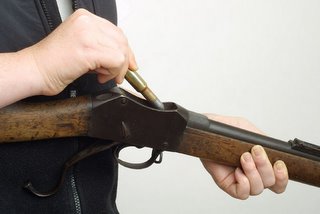The adoption of the Snider breechloading conversion of the old P.1853 Enfield by the British army in 1866 was never intended to be more than a stopgap. Indeed, the commission to select its replacement was formed in 1867, and soon weeded a field of over 100 entrants down to nine finalists. While bolt-actions were considered, a falling block with an internal striker ignition system designed by Swiss engineer Friedrich von Martini was selected, mated to a barrel with 7-groove, 1-in-22" rifling that had been the brainchild of Scottish gun-maker and rifle marksmanship enthusiast Alexander Henry. From such dry technical details was a legend born.
The Martini-Henry was the standard issue arm of the British military from 1871 through the early 1890's; twenty tumultuous years, spanning such famous names as Khartoum, Isandhlwana, Rorke's Drift. The rifle itself has been the star of Kipling poetry and Hollywood film, with a sword bayonet on one end and Tommy Atkins at the other.
Operation of the rifle is simple: pulling down on the lever behind the triggerguard causes the beechblock to drop at the front, exposing the chamber and automatically cocking the striker. The lever is then raised, closing the chamber and preparing the weapon for firing. There is no safety, but a pivoting indicator on the right side of the action gives visual and tactile confirmation of the weapon's cocked status. After firing, operation of the lever causes twin extractors to eject the spent case. There is a lug for a bayonet on the right side of the first barrel band, and the weapon's sights are graduated to 1,450 yards (experiments in India against screen targets representing massed troops showed that trained riflemen could achieve 6% hits in volley fire out to 1,650 yards!) Recoil was, as they say in the gun mags, "brisk but manageable", and a cutout was placed in the right rear of the receiver to remind one not to wrap one's thumb over the action, which could cause it, upon firing, to meet one's nose with enough force to make one see stars.
The Martini was truly a weapon of transition; a crusty veteran issued one in 1871 may well have received his first marksmanship instruction on a smoothbore flintlock, while the senior NCO's at Mons and First Ypres had undoubtedly cut their teeth on this old black powder warhorse. Ammunition, usually formed from 24ga shotgun brass, is still available from some specialty houses, such as Old Western Scrounger and Rocky Mountain Cartridge, LLC. Be aware that these black powder cartridges are loaded with .451" bullets, and that the bore on a well-used Martini (like mine) can mike out to .458" or more, resulting in keyholing at ranges as close as seven yards. I would encourage any military rifle enthusiast to snag one of these while examples are still available from International Military Antiques and Atlanta Cutlery; there may be no more romantic breechloader to own.
Subscribe to:
Post Comments (Atom)




3 comments:
When half o' your bullets go wide in the ditch,
Don't call your Martini a cross-eyed old bitch.
She's as human as you are, you treat her as sich ...
Good article, Tamara.
pax
Where did you get the hat? It would make a great Christmas gift for a couple of my friends.
Brass
"Where did you get the hat?"
Correia, a member at both The High Road and The Firing Line, does runs of Molon Labe gear two or three times a year.
Post a Comment